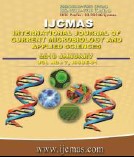


 National Academy of Agricultural Sciences (NAAS)
National Academy of Agricultural Sciences (NAAS)

|
PRINT ISSN : 2319-7692
Online ISSN : 2319-7706 Issues : 12 per year Publisher : Excellent Publishers Email : editorijcmas@gmail.com / submit@ijcmas.com Editor-in-chief: Dr.M.Prakash Index Copernicus ICV 2018: 95.39 NAAS RATING 2020: 5.38 |
In the present study extracellular polysaccharide (EPS) was characterized from Pseudomonas aeruginosa B01. EPS was purified using ethanol precipitation and dialysis. The purified EPS from P. aeruginosa B01 was analyzed using a High Performance Liquid Chromatography (HPLC). The infrared spectra of EPS from P. aeruginosa B01 clearly showed the presence of carboxylate groups. The FT-IR spectrum indicated an intense absorption band in the region of 3296 cm-1 on the stretching vibration of hydroxyl groups (OH). The bands in the region of 2941 cm-1 and 1627 cm-1 are due to stretching vibrations of C-H bonds. The absorption in the region of 1029.99 cm-1 indicated the presence of glycoside link in the alpha (α) conformation. A C=O stretch between at 1730 and 1700 indicated the presence of carboxylic acid group. The monosaccharide composition of hydrolyzed EPS was analyzed using Gas Chromatography – Mass Spectrophotometry (GC-MS). GC-MS analysis revealed the presence Octasiloxane, 1, 1, 3, 3, 5, 5, 7, 7, 9, 9, 11, 11, 13, 13, 15, 15 – Hexadecamethyl, D-mannose, N-Hexadecanoic acid, Cyclohexane, 1-(1,5, Dimethylhexyl)4-(4-methylpentyl)-, D-galactose, Cyclotrisiloxane, hexamethyl-, and D-glucose were detected. Nuclear Magnetic Resonance (NMR) spectrum of EPS from P. aeruginosa B01 revealed two peak signals at 3.6 ppm and 6 ppm. The 1H NMR spectrum of EPS from P. aeruginosa B01 showed that protons appeared at 6.131, 6.113, 6.096, 6.078, 3.651, 3.633 and 3.615 ppm. The anomeric protons of residues and their chemical shift at these ppm suggest these residues are α and β linked. Although, NMR peaks are poorly resolved because of viscosity, the characteristic signals for glucan (a branched polysaccharide chain with either 1, 4 or 1, 3 and 1, 6 linkage) anomeric protons could be detected. The 1H NMR spectra of EPS extracted from P. aeruginosa B01 exhibited characteristic chemical shifts (ppm) and corresponding functional groups. Acid hydrolysis of EPS was carried out using H2SO4 and yielded hydrolyzed product of polysaccharide monomers. The purified EPS showed potent activity against mosquito larvae.
 |
 |
 |
 |
 |